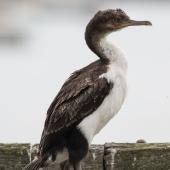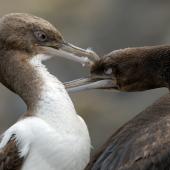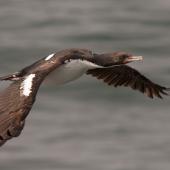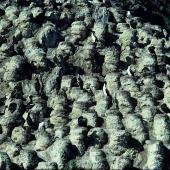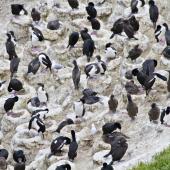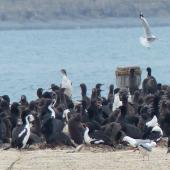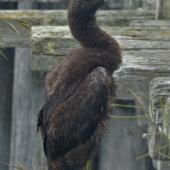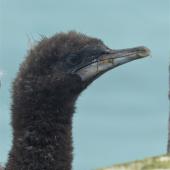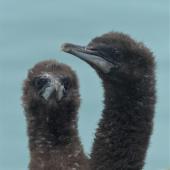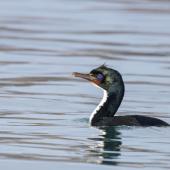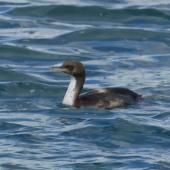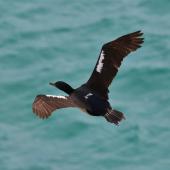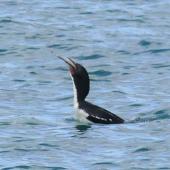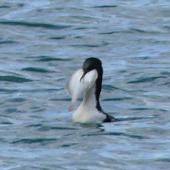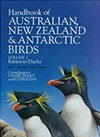Otago shag | Matapo
Leucocarbo chalconotus (G.R. Gray, 1845)
Order: Suliformes
Family: Phalacrocoracidae
New Zealand status: Endemic
Conservation status: Recovering
Other names: bronze shag, kawau, Stewart Island shag, Gray’s shag
Geographical variation: Two colour morphs, bronze and pied, which inter-breed
Otago shags are large marine shags with variable plumage, found only on the south-eastern South Island. The pied morph has striking black-and-white plumage, whilst the bronze form appears brown, but is iridescent in the right lighting conditions. On Otago Harbour, Otago shags are seen in ‘line astern’ squadrons heading to and from foraging grounds. The flocking behaviour, heavy build and flight close to the water is diagnostic within its range. The habit of group foraging in murky water places Otago shags at risk from set-net entanglement.
Identification
The Otago shag is a large pink-footed shag of the south-eastern South Island. The pied morph (making up 20-30% of the population) has a dark head and white belly and throat, with white patches on the otherwise black wings. These appear as a white bar when the wings are folded. The back feathers are black with a blue sheen, and the tail is black. The bronze morph (making up 70-80% of the population) is entirely brownish-black, with a green sheen on the wings and blue sheen on the body. The bill is pale brown, pink or grey with a dark culmen ridge; the iris is brown. In breeding plumage around 50% of both morphs have small bright orange caruncles above the base of the bill, while the other 50% have dark orange scattered papillae (cf. yellow caruncles on king shags). Both morphs have a dark orange or purple gular pouch (facial colouring). Non-breeding birds are similar, but have duller facial skin colour and no crests. Juveniles are also dimorphic (i.e. pied or bronze) but are duller with pale facial skin and no caruncles. Birds of all ages fly with their necks straight.
Voice:
Only reported at breeding colonies. When seeking a mate, males use a borr call. Males returning to the nest call with a soft eh-eh-eh; females remain silent. Chicks beg for food with a squeaky ah-whee-ah.
Similar species
Around south-eastern New Zealand, Otago shag can be confused with the smaller Foveaux shag. Methods to separate pied morphs from either Foveaux shag, king shag or Chatham Island shag are poorly understood. This has been problematic for extra-limital sightings of pied, pink-footed shags at Godley Head, Banks Peninsula, and at Kaikoura.
The pied morph of Otago shag may be confused with the similarly-sized pied shag, and the bronze morph may be confused with the black shag. Both pied and black shags have black feet and fly with an S-shaped neck. Pied shags have more white on their face, and lack white patches on their upper wings. Pied and black shags are more likely to perch in trees, whereas Otago shags do not.
Distribution and habitat
Holocene fossil and archaeological midden assemblages indicate that at the time of Polynesian arrival ca. 1280 AD Otago shag was spread across the eastern South Island from Marfells Beach, Marlborough to the Catlins. Within one hundred years of human arrival, over-hunting, habitat destruction, and the impact of kiore and kuri had caused a pronounced population genetic bottleneck, with Otago shag losing >95% of its genetic variation, and becoming restricted to rocky cliffs and islands off Otago. Otago shags have recently extended their range northwards and southwards, and now occur on the south-eastern South Island from the southern Catlins (The Sisters, Kinakina Island) north to the Waitaki River. There are recent sightings as far north as Banks Peninsula. The number of nesting sites in Otago has increased in recent years. It is not known whether this is an overall increase in numbers, or movement out of their post-human contact historical range.
Otago shags are birds of coastal waters and harbours. They roost on headlands, small islands and on man-made structures (e.g. Sumpter wharf, Oamaru).
Population
Prior to the taxonomic splitting of Otago and Foveaux shag (previously, both were recognised as the Stewart Island shag), combined estimates varied between 1600-1800 pairs, to fewer than 5000 birds.
Threats and conservation
Otago shags are at risk from fishing interactions, particularly entanglement in set-nets, but occasionally by being shot (illegally) by fishers. Other threats include disturbance at breeding colonies. In Otago, all large successful breeding colonies are on islands, or in protected areas or sites otherwise inaccessible to the public.
Breeding
Otago shags are colonial nesters in both small and large colonies, in areas where there is easy access to the sea and little disturbance. Typically these include steep slopes, rocky cliffs or bluffs. The pedestal nests are made of seaweed, sticks and grass cemented with guano. Each nest is just out of pecking reach of the next nest. Nest material is often stolen from unguarded nests. Colonies may persist for many years, or be suddenly abandoned. Breeding season may vary between years and colonies. Otago shag breeding behaviour and ecology has not been well studied. The 1-3 eggs are laid from May to September. Breeders are probably monogamous, and share incubation. Chicks are mainly fed in the afternoon, and beg for food with a squeaky call from one week old. They breed from three-years-old.
Behaviour and ecology
Otago shags may roost in large flocks on headlands or man-made structures (e.g. Sumpter wharf in Oamaru). Flocks flying to or from grounds fly in long lines close to the water. They have been recorded flying up to 10 km off the Otago coast.
Food
Otago shags forage in groups, in water up to 30 m. They are able to successfully forage in murky water such as in the inner Otago Harbour. In such conditions the foraging strategy is based on ‘disturb and strike’ rather than ‘see and chase’. The diet is mainly seabed-dwelling fish (Otago Harbour 70% by weight) such as flounder and bullies. Invertebrates such as crabs, shrimps and polychaete worms are also taken. The diet varies seasonally, with fish making up more in spring (85% by weight) and less in winter (45% by weight).
Weblinks
http://www.nzbirds.com/birds/shagstewartisland.html
References
Crossland, A.C. 2012. A review of the current range of Stewart Island shag (Leucocarbo chalconotus) and two records from Lake Ellesmere, Canterbury. Notornis 59: 71-73.
Heather, B.D.; Robertson, H.A. 1996 (rev 2000). The field guide to the birds of New Zealand. Viking, Auckland.
Lalas, C. 1983. Comparative feeding ecology of New Zealand marine shags (Phalacrocoracidae). Ph.D. thesis (Zoology). University of Otago, Dunedin.
Lalas, C.; Perriman, L. 2009. Nest counts of Stewart Island shags/mapua (Leucocarbo chalconotus) in Otago. DOC Research & Development Series 314. 29 p. Department of Conservation, Wellington.
Marchant, S.; Higgins, P.J. (eds.) 1990. Handbook of Australian, New Zealand and Antarctic birds. Vol. 1, ratites to ducks. Oxford University Press: Melbourne.
Parker, G.C.; Rexer-Huber, K. 2021. Foveaux and Otago shag population census methods: drone and camera trials. DRAFT final report for BCBC2020-24 for the Department of Conservation. Dunedin, Parker Conservation.
Rawlence, N.J.; Till, C.E.; Scofield, R.P.; Tennyson, A.J.D.; Collins, C.J.; Lalas, C.; Loh, G.; Matisoo-Smith, E.; Waters, J.M.; Spencer, H.G.; Kennedy, M. 2014. Strong phylogeographic structure in a sedentary seabird, the Stewart Island shag (Leucocarbo chalconotus). PLoS One 9: e90769.
Rawlence, N.J.; Kennedy, M.; Anderson, C.N.K.; Prost, S.; Till, C.E.; Smith, I.W.G.; Scofield, R.P.; Tennyson, A.J.D.; Hamel, J.; Lalas, C.; Matisoo-Smith, E.A.; Waters, J.M. 2015. Geographically contrasting biodiversity reductions in a widespread New Zealand seabird. Molecular Ecology 24: 4605-4616.
Rawlence, N.J.; Scofield, R.P.; Spencer, H.G; Lalas, C.; Easton, L.J.; Tennyson, A.J.D.; Adams, M.; Pasquet, E.; Fraser, C.; Waters, J.M.; Kennedy, M. 2016. Genetic and morphological evidence for two species of Leucocarbo shag (Aves, Pelecaniformes, Phalacrocoracidae) from southern South Island of New Zealand. Zoological Journal of the Linnean Society 177: 676-694.
Rawlence, N.J.; Salis, A.T.; Spencer, H.G.; Waters, J.M.; Scarsbrook, L.; Mitchell, K.J.; Phillips, R.A.; Calderon, L.; Cook, T.R.; Bost, C-A.; Dutoit, L.; Masello, J.F.; Nupen, L.J.; Quillfeldt, P.; Ratcliffe, N.; Ryan, P.G.; Till, C.E.; Kennedy, M. 2022. Rapid radiation of Southern Ocean shags in response to receding sea ice. Journal of Biogeography 49: 942-953.
Robertson, C.J.R.; Hyvönen, P.; Fraser, M.J.; Pickard, C.R. 2006. Atlas of bird distribution in New Zealand 1999-2006. Ornithological Society of New Zealand, Wellington.
Robertson, H.A; Baird, K.; Elliott, G.P.; Hitchmough, R.A.; McArthur, N.J.; Makan, T.; Miskelly, C.M.; O’Donnell, C.F.J.; Sagar, P.M.; Scofield, R.P.; Taylor, G.A.; Michel, P. 2021. Conservation status of birds in Aotearoa New Zealand birds, 2021. New Zealand Threat Classification Series 36. Wellington, Department of Conservation. 43p.
Recommended citation
McKinlay, B.; Rawlence, N.J. 2022. Otago shag | Matapo. In Miskelly, C.M. (ed.) New Zealand Birds Online. www.nzbirdsonline.org.nz
Otago shag | Matapo
- Social structure
- monogamous
- Breeding season
-
- Jul
- Aug
- Sep
- Oct
- Nov
- Dec
- Jan
- Feb
- Mar
- Apr
- May
- Jun
- Nest type
- mud nest
- Nest description
- Nests are of a top hat design, where vegetation is gathered and incorporated into the nest and cemented by faeces. The nest builds up over the season, about 0.5m wide.
- Nest height (min)
- 1 m
- Nest height (max)
- 1.5 m
- Clutch size (mean)
- 2
- Clutch size (min)
- 1
- Clutch size (max)
- 3
- Mean egg dimensions (length)
- 66 mm
- Mean egg dimensions (width)
- 42 mm
- Egg colour
- Pale blue
- Egg laying dates
-
- Jul
- Aug
- Sep
- Oct
- Nov
- Dec
- Jan
- Feb
- Mar
- Apr
- May
- Jun
- Interval between eggs in a clutch
- Unknown days
- Incubation behaviour
- shared
- Incubation length (mean)
- Unknown
- Nestling type
- altricial





